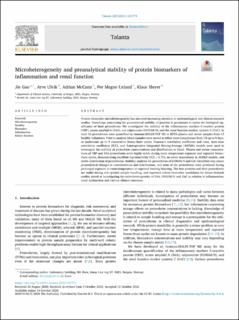| dc.contributor.author | Gao, Jie | |
| dc.contributor.author | Ulvik, Arve | |
| dc.contributor.author | McCann, Adrian | |
| dc.contributor.author | Ueland, Per Magne | |
| dc.contributor.author | Meyer, Klaus | |
| dc.date.accessioned | 2022-04-20T07:40:38Z | |
| dc.date.available | 2022-04-20T07:40:38Z | |
| dc.date.created | 2021-05-10T11:22:27Z | |
| dc.date.issued | 2021 | |
| dc.identifier.issn | 0039-9140 | |
| dc.identifier.uri | https://hdl.handle.net/11250/2991491 | |
| dc.description.abstract | Protein biomarker microheterogeneity has attracted increasing attention in epidemiological and clinical research studies. Knowledge concerning the preanalytical stability of proteins is paramount to assess the biological significance of their proteoforms. We investigated the stability of the inflammatory markers C-reactive protein (CRP), serum amyloid A (SAA), and calprotectin (S100A8/9), and the renal function marker, cystatin C (CnC). In total 16 proteoforms were quantified by immuno-MALDI-TOF MS in EDTA plasma and serum samples from 15 healthy volunteers. Prior to analysis blood samples were stored at either room temperature from 1 h up to 8 days, or underwent up to 9 consecutive freeze/thaw cycles. Pearson's correlation coefficient and t-test, intra-class correlation coefficient (ICC), and Autoregressive Integrated Moving-Average (ARIMA) models were used to investigate the stability of proteoform concentrations and distributions in blood. Plasma and serum concentrations of CRP and SAA proteoforms were highly stable during room temperature exposure and repeated freeze/thaw cycles, demonstrating excellent reproducibility (ICC > 0.75), no serial dependency in ARIMA models, and stable distribution of proteoforms. Stability analyses for proteoforms of S100A8/9 and CnC identified only minor preanalytical changes in concentrations and distributions, and none of the proteoforms were produced during prolonged exposure to room temperature or repeated freezing/thawing. The four proteins and their proteoforms are stable during sub-optimal sample handling, and represent robust biomarker candidates for future biobank studies aimed at investigating the microheterogeneity of SAA, S100A8/9, and CnC in relation to inflammation, renal dysfunction and various clinical outcomes. | en_US |
| dc.language.iso | eng | en_US |
| dc.publisher | Elsevier | en_US |
| dc.rights | Navngivelse 4.0 Internasjonal | * |
| dc.rights.uri | http://creativecommons.org/licenses/by/4.0/deed.no | * |
| dc.title | Microheterogeneity and preanalytical stability of protein biomarkers of inflammation and renal function | en_US |
| dc.type | Journal article | en_US |
| dc.type | Peer reviewed | en_US |
| dc.description.version | publishedVersion | en_US |
| dc.rights.holder | Copyright 2020 The Author(s) | en_US |
| dc.source.articlenumber | 121774 | en_US |
| cristin.ispublished | true | |
| cristin.fulltext | original | |
| cristin.qualitycode | 1 | |
| dc.identifier.doi | 10.1016/j.talanta.2020.121774 | |
| dc.identifier.cristin | 1909119 | |
| dc.source.journal | Talanta: The International Journal of Pure and Applied Analytical Chemistry | en_US |
| dc.identifier.citation | Talanta. 2021, 223, Part 1, 121774. | en_US |
| dc.source.volume | 223 | en_US |
| dc.source.issue | Part 1 | en_US |

